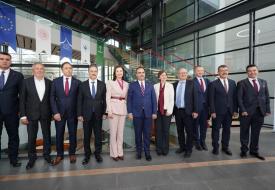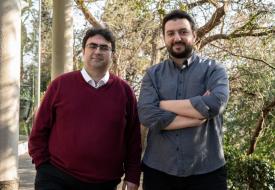24/7 tracking of endangered puffinus birds
With the support of TÜBİTAK and led by Boğaziçi University Institute of Environmental Sciences, the project "Conservation of puffinus birds in the Mediterranean Basin and the Black Sea using Next-Generation Genomic, Acoustic, and GPS-GSM Tracking Methods" has been implemented with the support of Ege University Department of Biology, Istanbul Technical University Eurasia Institute of Earth Sciences, Mediterranean Science Commission (CIESM), Turkish Marine Research Foundation, and Istanbul University Faculty of Aquatic Sciences. In this project, satellite transmitters were attached to 30 puffinus birds in the İstanbul Strait.
Following a challenging tracking and capturing process, the transmitters attached to the birds' backs will transmit location data for approximately two months until they fall off with the molting of feathers. This way, it will be possible to gather information about the migration routes and breeding colonies of this unique and endangered species.
"THEY ARE AT RISK"
The project's leader, Prof. Dr. Raşit Bilgin from the Boğaziçi University Institute of Environmental Sciences, shares that puffinus birds, which are abundant in the Western Mediterranean and the Black Sea, are an agile species of seabirds.
The scientist expresses that this species, which can glide very close to the sea surface for kilometers, is endangered. He says, "The highly agile puffinus birds pass through the Istanbul Strait during their journeys between the Western Mediterranean and the Aegean Sea to the Black Sea. You may occasionally see these birds rapidly advancing in triangular formation in the sky. They can fly for kilometers at speeds of up to 70 kilometers per hour, very close to the sea, and are experts in fishing as seabirds. However, this species is endangered, and every project we undertake to protect them carries great significance.”

"WE LISTEN TO THEIR SOUNDS AS WELL AS SATELLITE TRACKING"
In the project, birds are tracked with transmitters, genetic maps are drawn, and acoustic monitoring is also carried out. Prof. Dr. Bilgin, stating that the 30 birds equipped with transmitters are tracked 24/7, says the following:
"In the project, supported by TÜBİTAK, we have three work packages. Firstly, we are using genetic materials obtained from the puffinus birds captured in our Istanbul Strait study, along with samples provided by our international partners from the Western Mediterranean and the Aegean Sea, to reveal the genetic relationships and connections between these different puffinus populations. Secondly, we are tracking these birds in Türkiye with acoustic equipment we have set up. Our goal here is to locate the nests of puffinus birds that produce different calls during the breeding season. If we capture mating calls, it will indicate that breeding areas are nearby. So far, we haven't come across any puffinus nests in Türkiye, and we are working to find them. Thirdly, we are tracking the 30 birds equipped with transmitters in the Istanbul Strait using GPS-GSM technology 24/7. These data will provide us with detailed information about the migration, feeding, and other behaviors of this species. I believe that through the analysis of the collected data, we will obtain valuable information about these birds and can contribute to their conservation efforts with this knowledge."

The large research team, including Prof. Dr. Raşit Bilgin and Dr. Dilek Şahin from Boğaziçi University Environmental Sciences, used a special method to attach a transmitter to the puffinus birds, which are very difficult to catch.
The method developed by Dr. Asaf Ertan from the Turkish Marine Research Foundation (TÜDAV), which involves setting up a net between two buoys to catch puffinus birds on the sea surface, was chosen. 30 puffinus birds were captured without causing any harm to the birds with this method.
Prof. Dr. Bilgin emphasized that this method is the first of its kind among the research conducted in the region, stating, "There is a significant challenge in conducting research with puffinus birds. These birds are very fast and agile, making it very difficult to catch them without causing harm. We failed in many attempts that we made in the İstanbul Strait with our project partners. Then, we succeeded using the method developed 28 years ago by Dr. Asaf Ertan. Capturing 30 birds while they were flying and subsequently attaching transmitters is a first in Europe. This will allow us to obtain data on a much larger number of individuals.”











